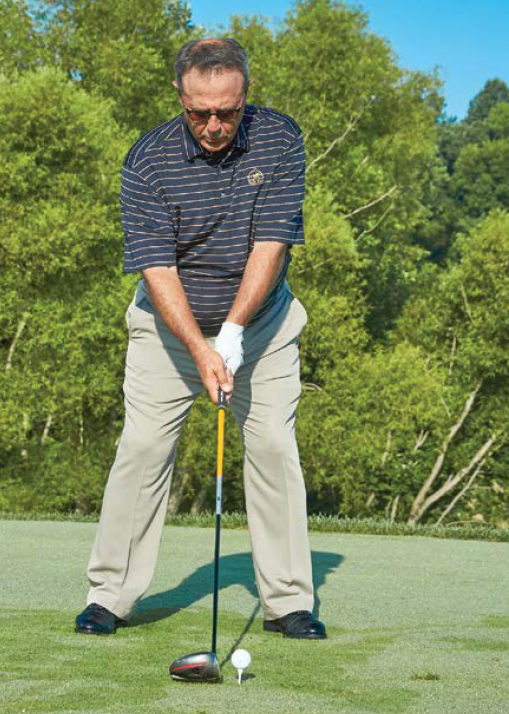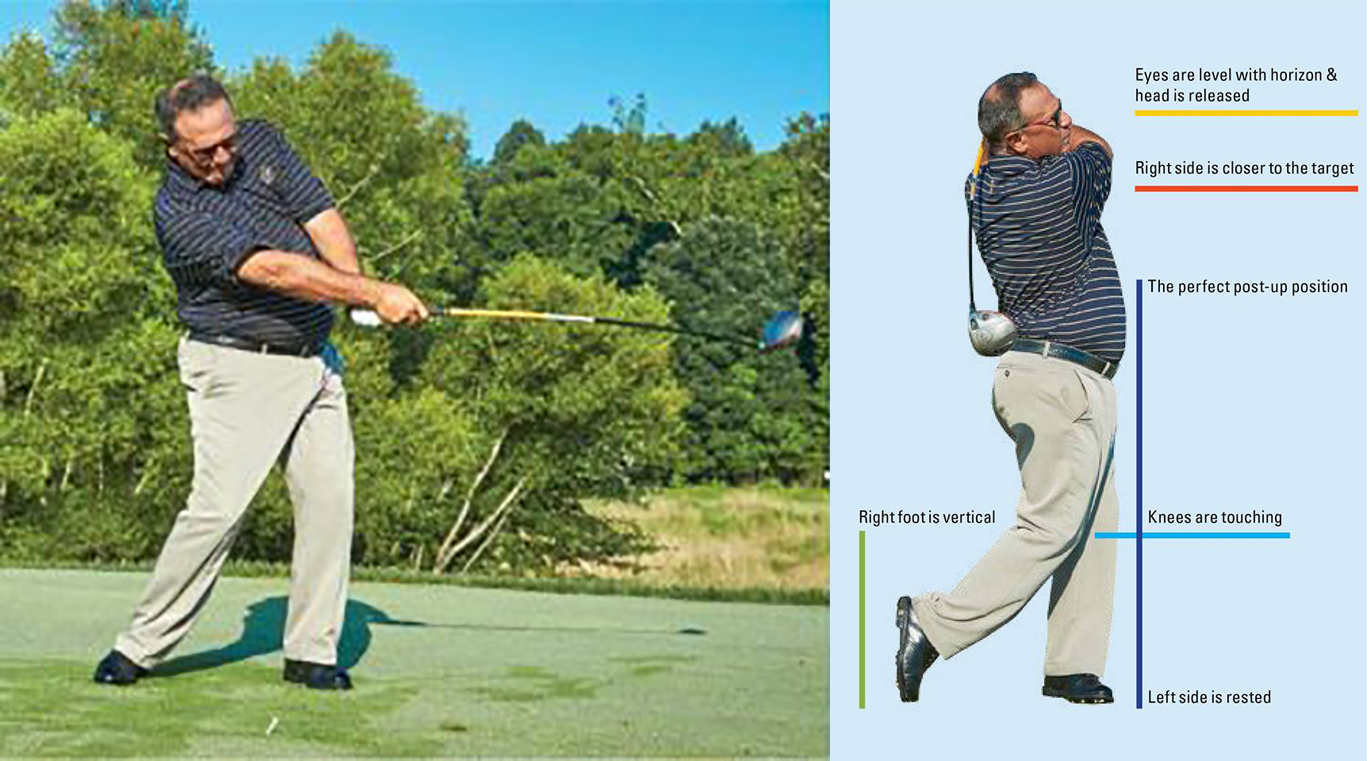The Launching Pad and Finish Condition Can Fix The In-Between!!
By Tom Patri, PGA
 Each golf season, as a full-time teacher/coach, I re-examine techniques that I use, as well as the techniques of others in my area of the golf industry. During the past ten years, we have watched golf instruction, as well as golf technique information evolve . The how-to’s, if you will, explode in abundance to the point where the student desperately needs someone to help them not only with their golf game, but with any potentially confusing information that might divert the student from a properly focused path to improvement. You see, as my dear friend and mentor, Mr. Bill Strausbaugh (1992 National PGA Teacher of the Year), repeatedly reminded me, “Proper golf instruction is based on a few key principals that are learned and then worked on forever!” It is my feeling that personal golf instruction, that is live instruction between professional and student, has become far too complex. I also feel strongly golf is severely over taught and undercoached.
Each golf season, as a full-time teacher/coach, I re-examine techniques that I use, as well as the techniques of others in my area of the golf industry. During the past ten years, we have watched golf instruction, as well as golf technique information evolve . The how-to’s, if you will, explode in abundance to the point where the student desperately needs someone to help them not only with their golf game, but with any potentially confusing information that might divert the student from a properly focused path to improvement. You see, as my dear friend and mentor, Mr. Bill Strausbaugh (1992 National PGA Teacher of the Year), repeatedly reminded me, “Proper golf instruction is based on a few key principals that are learned and then worked on forever!” It is my feeling that personal golf instruction, that is live instruction between professional and student, has become far too complex. I also feel strongly golf is severely over taught and undercoached.
An instructor should first diagnose a student’s motion and decide in his or her own mind on a starting point. Sound fundamentals affect any golf motion. They must in fact be solidly in place first: grip, base, ball position, posture, spacing, weight distribution, alignment, tension levels of the arms and hands. All these items form the launching pad (traditionally called the setup) The First Bookend.
The launching pad is a static condition that is not in motion as opposed to a dynamic condition (the swing itself-having motion). I feel strongly – why move on in the teaching/coaching relationship if the student’s launching pad is, in fact, not fundamentally sound. AFTER 30+ years of teaching and coaching the game of golf I feel strongly that ALL DYNAMIC SWING CANCERS CAN BE TRACED BACK TO THE LAUNCHING PAD / SET UP !! I also feel very strongly that most students who come for instruction at the club level: (1) don’t understand the vital importance of a sound launching pad, and (2) don’t realize how dramatically the cause and-effect results of improper launching pad conditions can affect the student’s ability to make solid contact with the ball on a regular basis. And next, produce the type of trajectory and ball flight on a consistent basis which will allow the student to control the ball and advance it around the course of play to produce a score that is acceptable.
 .
.
Please allow me to give you an example. It has been my experience as an instructor that the vast majority of club players (also often Tour players and club professionals) that I have been privileged to work with, tend to align themselves too far into right field ( right handed players ) with their bodies; therefore, their club face is often aiming right of the foul line (or you might say into the right rough). Let me explain first what poor alignment causes. I like to view the target area in front of the player (i.e., the fairway off the tee and the green for my approach shots) as a baseball diamond. When I prepare a student to both optically as well as conceptually understand alignment, I ask he or she to feel as if they would like to aim their club face at the second base bag and their body lines (feet, knees, hips, and shoulders) at the shortstop. I also stress the shoulders may feel slightly (and I stress slightly) more left than the shortstop. Most players, I encounter, will aim their body, not club face, at the second base bag and their club face at the second baseman while optically they’re commanding the nerve center to propel the ball over second base. Their conscious intent and their perceived actuality doesn’t match; therefore, disaster looms.
Often from this setup condition, the club is swung early inside, then lifted, and then rerouted over the top to compensate for a bad alignment condition. This leads to a very steep angle of attack and ball flights that are either pulls or pull slices, often both. The only difference being the club face condition at impact. The most recognizable problem with this is for a player whose normal 5-iron may fly 175 yards, the pull will go long left 190 yards and the pull slice will go short right 150 yards, so it’s easy to see how this may be a very difficult way to play and score.
The above scenarios are generic in explanation. These problems are just a few of the issues I see on the lesson tee each and every day. Most students want you to fix their golf swing, and when you discuss the launching pad with them, they look at you as if to say, “No, my swing, my swing!” Never believing in their heart that the relationship between the two (launching pad and swing motion) is so vital. Better yet, never understanding that the only sure way to cure their ills is to start with the launching pad. The correction, in fact, must start there! When I am finally able to get a student to buy into the importance of the launching pad and I physically lead them into an exact condition (that is a proper setup condition via a well constructed and executed PRE-SHOT ROUTINE ) from which I’d like them to begin, it often, in many ways, feels extremely strange to the patient. This is a true sign that their golf motion has actually been strangled by an improper launching pad.
Much of the work is not live action, like hitting balls on the practice tee. It is, instead, done in front of a mirror. On my lesson tee I have a full length mirror, as well as numerous still photos of various world-class players, for the student to see fundamental sound launching pad conditions. Through excessive repetition of the process they can make constant visual comparisons between their image in the “understanding mirror” and the photos . The best way to convince a student that what is occurring is in fact correct, is to put them in a situation where they could best possibly convince themselves and of course see success ! Feel is not always real, but seeing is believing (especially when there is a real comparison).
In my entire career of both playing the game competitively as well as teaching and coaching the game, the number of launching pads I’ve seen at the club level that looked as if they would produce a desirable ball flight without the need of compensation could be counted on one hand. Conversely, during my time working with players on both the PGA and LPGA tours, I would count the launching pads that looked unable to produce a satisfactory result on one hand. Tour players look fundamentally ready to go.
As I switch my focus to the finish condition, I can hear folks out there screaming: “What about the in-between? What about my backswing? My transition? My leg drive? My shoulder turn? My impact condition, etc., etc.?” It is my belief not to ignore all of the above, because in my student’s swing, each of the above could be an issue, and I do, at the proper point in our instructional relationship, address all of the above if necessary. It is my feeling, however, my strong feeling, that if I can posture and position my students’ launching pad correctly and also allow them to feel and understand the conditions (feelings, visuals) of their finish (i.e., The Bookends!) they will have a heck of a chance of making an improved, dynamic motion in between these two static conditions.
Please allow me to continue. Conditions of the finish include the following:
- A level shoulder condition.
- A level hip/pelvic condition.
- A vertical right foot.
- A right knee that finds a relationship with (touching and behind) the left knee.
- A vertical spinal column.
- A level head and level eyes looking level at the horizon.
- A feeling of balance dictated by your ability to swing at a controllable pace!
All of the above conditions for the club player usually need to be learned traits through, once again, the use of a mirror and many repetitions. I would usually start by taking some film of the student’s motion, and simply freezing the film at the point of their own full finish. Of course, by showing them them a point-by-point comparison with any world class ball striker male or female. The pictures don’t lie.
Teaching my players to ” POST UP ” as I refer to it into a balanced controlled finished condition is vital. It has been my overwhelming experience that as I’m able to fundamentally modify both the players launching pad and post up condition the in betweens start to beautifully full into place. GT
Tom Patri is The Director of Instruciton at The Hawthorns in Fishers, IN.. Tom is a 4X PGA Teacher of the Year in both the N.Y. Metropolitan PGA Section and South Florida PGA Section.
To schedule lesson time with Tom email tpatri@mindspring.com or text 239-404-7790. Be sure to include all your contact information..
www.golftipsmag.com







